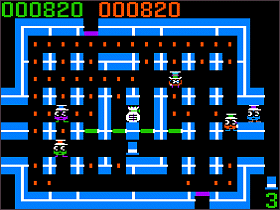 The Game: You’re in charge of a getaway car loaded with crafty criminals. Your job is to sneak around the maze, avoid four colorful cops who are hot on your trail, and grab all the dough – and, of course, to escape so you can steal again another day. But the cops can trap you with a series of doors that can prevent you from getting away… (M Network [Mattel Electronics], 1983)
The Game: You’re in charge of a getaway car loaded with crafty criminals. Your job is to sneak around the maze, avoid four colorful cops who are hot on your trail, and grab all the dough – and, of course, to escape so you can steal again another day. But the cops can trap you with a series of doors that can prevent you from getting away… (M Network [Mattel Electronics], 1983)
Memories: Released early in 1983, this version of Lock ‘N’ Chase further proves my “M Network theory,” which is as follows: somehow, no matter what hardware platform it’s on, an M Network game always winds up somehow looking like it’s a port of an Intellivision game. Not that this detracts from the fun factor of having a decent maze chase game on the Apple II, mind you.

 The Game: An evil force near the planet Jupiter has commandeered the asteroid belt between that giant planet and Mars as its personal defense shield. Your mission is simple: man a mobile weapons platform on the inner solar system’s side of the asteroid belt, exchange fire with the enemy (who can be the computer or another player), and try to knock out their defenses and destroy them. The battle will last only a brief time, and whoever has the best score – with a bonus given at the end for losing the least ships – wins. (Milton Bradley, 1983)
The Game: An evil force near the planet Jupiter has commandeered the asteroid belt between that giant planet and Mars as its personal defense shield. Your mission is simple: man a mobile weapons platform on the inner solar system’s side of the asteroid belt, exchange fire with the enemy (who can be the computer or another player), and try to knock out their defenses and destroy them. The battle will last only a brief time, and whoever has the best score – with a bonus given at the end for losing the least ships – wins. (Milton Bradley, 1983)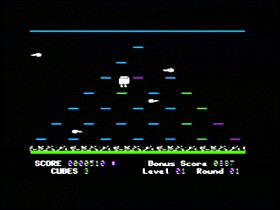 The Game: You’re Mr. Cool, an ice cube who chills out while hopping around a pyramid-shaped series of platforms. Fireballs streak across the pyramid from time to time, and they’ll melt you if they touch you. If you can stay cool long enough, you can advance through the game by changing the color of every platform to your target color by hopping onto each one – though in later levels it’ll take more than one hop, putting you in the path of more fireballs that could cause you to lose your cool. If you have one meltdown too many, the game is over. (Sierra On-Line, 1983)
The Game: You’re Mr. Cool, an ice cube who chills out while hopping around a pyramid-shaped series of platforms. Fireballs streak across the pyramid from time to time, and they’ll melt you if they touch you. If you can stay cool long enough, you can advance through the game by changing the color of every platform to your target color by hopping onto each one – though in later levels it’ll take more than one hop, putting you in the path of more fireballs that could cause you to lose your cool. If you have one meltdown too many, the game is over. (Sierra On-Line, 1983) The Game: As the bride of that most famous of single-celled omniphage life forms, your job is pretty simple – eat all the dots, gulp the large blinking dots in each corner of the screen and eat the monsters while they’re blue, and avoid the monsters the rest of the time. Occasionally various fruits and other foods will bounce through the maze, and you can gobble those for extra points. (Atarisoft, 1983)
The Game: As the bride of that most famous of single-celled omniphage life forms, your job is pretty simple – eat all the dots, gulp the large blinking dots in each corner of the screen and eat the monsters while they’re blue, and avoid the monsters the rest of the time. Occasionally various fruits and other foods will bounce through the maze, and you can gobble those for extra points. (Atarisoft, 1983)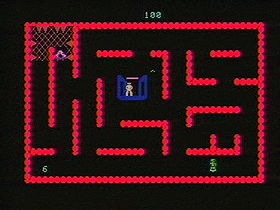 The Game: You’re alone, unarmed, in a maze full of bats, bugs and ‘bots, most of whom can kill you on contact (though the robots would happily shoot you rather than catching up with you). Loaded guns appear periodically, giving you a limited number of rounds with which to take out some of these creepy foes, though your shots are best reserved for the robots and spiders, who have a slightly more malicious intent toward you than the bats. If you shoot the bats, others will appear to take their place. If you shoot the ‘bots, the same thing happens, only a faster, sharper-shooting model rolls out every time. Your best bet is to stay on the move, stay armed, conserve your firepower – and don’t be afraid to head back to your safe room at the center of the screen. (Mattel Electronics, 1983)
The Game: You’re alone, unarmed, in a maze full of bats, bugs and ‘bots, most of whom can kill you on contact (though the robots would happily shoot you rather than catching up with you). Loaded guns appear periodically, giving you a limited number of rounds with which to take out some of these creepy foes, though your shots are best reserved for the robots and spiders, who have a slightly more malicious intent toward you than the bats. If you shoot the bats, others will appear to take their place. If you shoot the ‘bots, the same thing happens, only a faster, sharper-shooting model rolls out every time. Your best bet is to stay on the move, stay armed, conserve your firepower – and don’t be afraid to head back to your safe room at the center of the screen. (Mattel Electronics, 1983) The Game: As a round yellow creature consisting of a mouth and nothing else, you maneuver around a relatively simple maze, gobbling small dots and evading four colorful monsters who can eat you on contact. In four corners of the screen, large flashing dots enable you to turn the tables and eat the monsters for a brief period. Periodically, assorted items appear near the center of the maze, and you can consume these for additional points as well. The monsters, once eaten, return to their home base in ghost form and return to chase you anew. If cleared of dots, the maze refills and the game starts again, but just a little bit faster… (Atarisoft, 1983)
The Game: As a round yellow creature consisting of a mouth and nothing else, you maneuver around a relatively simple maze, gobbling small dots and evading four colorful monsters who can eat you on contact. In four corners of the screen, large flashing dots enable you to turn the tables and eat the monsters for a brief period. Periodically, assorted items appear near the center of the maze, and you can consume these for additional points as well. The monsters, once eaten, return to their home base in ghost form and return to chase you anew. If cleared of dots, the maze refills and the game starts again, but just a little bit faster… (Atarisoft, 1983) The Game: Pogo Joe has a pogo stick, a screen full of barrels whose colors need to be changed to the same target color, and a bunch of bouncy enemies too. Players guide Joe from barrel to barrel, sometimes requiring a big bounce if a barrel isn’t immediately adjacent to Joe’s current location, avoiding enemy creatures who are out to get him. Joe advances to the next level when the color of every barrel on the screen has been changed. A limited number of barrels per level act as a kind of “smart bomb” – landing on them wipes out all of Joe’s enemies temporarily (though they quitely repopulate the screen). (Screenplay, 1983)
The Game: Pogo Joe has a pogo stick, a screen full of barrels whose colors need to be changed to the same target color, and a bunch of bouncy enemies too. Players guide Joe from barrel to barrel, sometimes requiring a big bounce if a barrel isn’t immediately adjacent to Joe’s current location, avoiding enemy creatures who are out to get him. Joe advances to the next level when the color of every barrel on the screen has been changed. A limited number of barrels per level act as a kind of “smart bomb” – landing on them wipes out all of Joe’s enemies temporarily (though they quitely repopulate the screen). (Screenplay, 1983)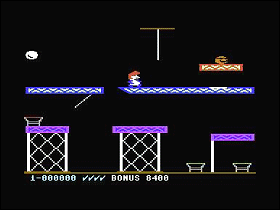 The Game: Help Sammy Lightfoot, circus performer extraordinaire, climb to the top of multiple levels by using trampolines, trapezes and your wits to avoid roaming meanies. (Sierra On-Line, 1983)
The Game: Help Sammy Lightfoot, circus performer extraordinaire, climb to the top of multiple levels by using trampolines, trapezes and your wits to avoid roaming meanies. (Sierra On-Line, 1983)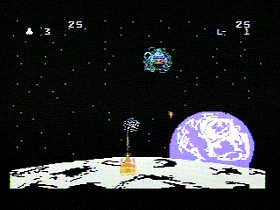 The Game: Demons coalesce into existence in mid-air above your cannon. Send them back where they came from by force. (Texas Instruments, under license from Imagic, 1983)
The Game: Demons coalesce into existence in mid-air above your cannon. Send them back where they came from by force. (Texas Instruments, under license from Imagic, 1983)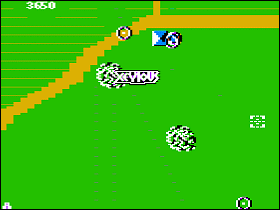 The Game: As the commander of a sleek Solvalou fighter, you’re deep into enemy territory, shooting their disc-shaped fighters out of the sky, bombing ground installations and artillery nests,bombing tanks, and trying to destroy the mothership. As you progress further behind enemy lines, heavier aircraft and more versatile and deadly ground-based defenses become the norm. (Mindscape, 1983)
The Game: As the commander of a sleek Solvalou fighter, you’re deep into enemy territory, shooting their disc-shaped fighters out of the sky, bombing ground installations and artillery nests,bombing tanks, and trying to destroy the mothership. As you progress further behind enemy lines, heavier aircraft and more versatile and deadly ground-based defenses become the norm. (Mindscape, 1983) The Game: As the pilot of a lone fighter infiltrating a spaceborne fortress, your mission is simple – survive long enough to vanquish the evil Zaxxon robot hidden deep within the fortress, and take out as much of the defenses as you can in the meantime. (Datasoft, 1983)
The Game: As the pilot of a lone fighter infiltrating a spaceborne fortress, your mission is simple – survive long enough to vanquish the evil Zaxxon robot hidden deep within the fortress, and take out as much of the defenses as you can in the meantime. (Datasoft, 1983) The Game: As the bride of that most famous of single-celled omniphage life forms, your job is pretty simple – eat all the dots, gulp the large blinking dots in each corner of the screen and eat the monsters while they’re blue, and avoid the monsters the rest of the time. Occasionally various fruits and other foods will bounce through the maze, and you can gobble those for extra points. (Atarisoft, 1983)
The Game: As the bride of that most famous of single-celled omniphage life forms, your job is pretty simple – eat all the dots, gulp the large blinking dots in each corner of the screen and eat the monsters while they’re blue, and avoid the monsters the rest of the time. Occasionally various fruits and other foods will bounce through the maze, and you can gobble those for extra points. (Atarisoft, 1983)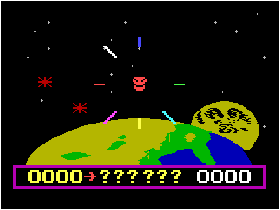 The Game: The game begins as the skull-like face of Spyruss the Deathless (the Timelord of Chaos, no less!) taunts you (well, only if you had the Voice), and then a bunch of pesky spaceships pops out of a vortex to shoot at you. They shoot at you rather a lot. Fortunately, you can shoot back with reckless abandon, but their ammunition – as you ascend into the higher levels of the game – can track you and even, if you don’t destroy their shots in mid-air, crawl along the ground briefly while you head for the opposite side of the screen, neatly trapped for their next volley. (Philips, 1983)
The Game: The game begins as the skull-like face of Spyruss the Deathless (the Timelord of Chaos, no less!) taunts you (well, only if you had the Voice), and then a bunch of pesky spaceships pops out of a vortex to shoot at you. They shoot at you rather a lot. Fortunately, you can shoot back with reckless abandon, but their ammunition – as you ascend into the higher levels of the game – can track you and even, if you don’t destroy their shots in mid-air, crawl along the ground briefly while you head for the opposite side of the screen, neatly trapped for their next volley. (Philips, 1983)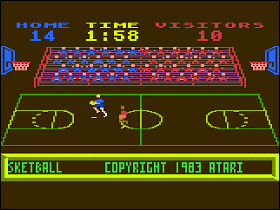 The Game: Two players each control one man in one-on-one, full-court action. Whoever has the highest score by a predetermined time limit wins. (Atari, 1983 [unreleased])
The Game: Two players each control one man in one-on-one, full-court action. Whoever has the highest score by a predetermined time limit wins. (Atari, 1983 [unreleased])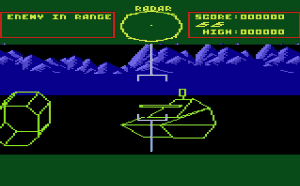 The Game: As the pilot of a heavy tank, you wander the desolate battlefield, trying to wipe out enemy tanks and landing vehicles. (Atari, 1983)
The Game: As the pilot of a heavy tank, you wander the desolate battlefield, trying to wipe out enemy tanks and landing vehicles. (Atari, 1983)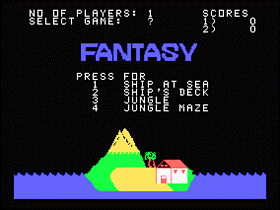 The Game: Pirates have kidnapped your girlfriend, Cheri, and it’s your job to rescue her, from landing your hot air balloon on the deck of the pirate ship and trying to free her, to flying and climbing your way through the jungle to rescue her from jungle animals who have abducted her from the pirates. (Texas Instruments, 1983 [unreleased])
The Game: Pirates have kidnapped your girlfriend, Cheri, and it’s your job to rescue her, from landing your hot air balloon on the deck of the pirate ship and trying to free her, to flying and climbing your way through the jungle to rescue her from jungle animals who have abducted her from the pirates. (Texas Instruments, 1983 [unreleased])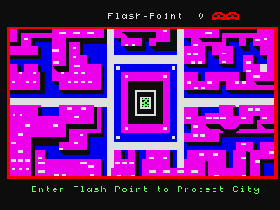 The Game: A zombie infestation has overrun the city. The player, in a mobile unit bristling with weapons, must venture into the infested areas and eliminate the zombies – or die. The center of the infestation screens features a green area surrounding the player’s vehicle; this must be preserved as much as possible while fighting off the zombies, as bonus points are awarded for guarding that space. If the player survives, it’s time to move on to the scene of the next zombie attack. (North American Philips, 1983 – unreleased prototype)
The Game: A zombie infestation has overrun the city. The player, in a mobile unit bristling with weapons, must venture into the infested areas and eliminate the zombies – or die. The center of the infestation screens features a green area surrounding the player’s vehicle; this must be preserved as much as possible while fighting off the zombies, as bonus points are awarded for guarding that space. If the player survives, it’s time to move on to the scene of the next zombie attack. (North American Philips, 1983 – unreleased prototype) The Game: You control a solitary swarm of “good” bees, trailed by a couple of handy ray guns on the same vertical axis. The game starts out with a bunch of dim-witted Beebots bumbling around the screen, which you can sting with your bee swarm until the ‘bots slow down and finally expire, marked by a rather grim little tombstone! This probably sounds easy enough, but there are killer bees from outer space emerging from hives around the edge of the play area, and when their swarms collide with your swarm, you lose bees. The only defense against the killer bees is a pair of ray guns, which have to recharge after every use. (North American Philips, 1983)
The Game: You control a solitary swarm of “good” bees, trailed by a couple of handy ray guns on the same vertical axis. The game starts out with a bunch of dim-witted Beebots bumbling around the screen, which you can sting with your bee swarm until the ‘bots slow down and finally expire, marked by a rather grim little tombstone! This probably sounds easy enough, but there are killer bees from outer space emerging from hives around the edge of the play area, and when their swarms collide with your swarm, you lose bees. The only defense against the killer bees is a pair of ray guns, which have to recharge after every use. (North American Philips, 1983)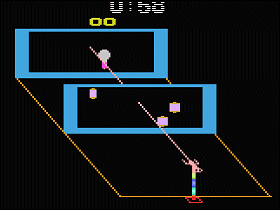 The Game: You’re manning an experimental laser in a shooting gallery, trying to zap objects as they cross a screen at the far end of the room. A direct hit scores points, but the clock is always ticking down and any objects that haven’t been shot down will remain in play until they’re eliminated. At the end of each round, you’ll be tasked with shooting the flame off of a candelabra, though its rapidly melting candles may make this trickier than you think. With each new level, targets get smaller – and rows of floating mirrors threaten to bounce your laser right back at you if you hit them instead of your target. (20th Century Fox, 1983 [never released])
The Game: You’re manning an experimental laser in a shooting gallery, trying to zap objects as they cross a screen at the far end of the room. A direct hit scores points, but the clock is always ticking down and any objects that haven’t been shot down will remain in play until they’re eliminated. At the end of each round, you’ll be tasked with shooting the flame off of a candelabra, though its rapidly melting candles may make this trickier than you think. With each new level, targets get smaller – and rows of floating mirrors threaten to bounce your laser right back at you if you hit them instead of your target. (20th Century Fox, 1983 [never released]) The Game: What if you were out to perform daring, air-show-style aerial acrobatics, and someone was shooting at you at the same time? Wouldn’t that be dandy? Lucky you, that’s what you’re doing in this game. With a mandate to DESTROY TERMINAL, you set out to obliterate an airport terminal protected by armed hot air balloons. The closer you get to carrying out that mission, the more fiercely they defend their turf. When you do level the terminal to the ground, a door opens up, allowing you to fly your plane into a massive maze of pipes, and if you can navigate that labyrinth, you reach “the end” – where you must fend off more adversaries to touch down safely and start again. (Coleco, 1983 – unreleased / recovered and released by CGE Services, 2003)
The Game: What if you were out to perform daring, air-show-style aerial acrobatics, and someone was shooting at you at the same time? Wouldn’t that be dandy? Lucky you, that’s what you’re doing in this game. With a mandate to DESTROY TERMINAL, you set out to obliterate an airport terminal protected by armed hot air balloons. The closer you get to carrying out that mission, the more fiercely they defend their turf. When you do level the terminal to the ground, a door opens up, allowing you to fly your plane into a massive maze of pipes, and if you can navigate that labyrinth, you reach “the end” – where you must fend off more adversaries to touch down safely and start again. (Coleco, 1983 – unreleased / recovered and released by CGE Services, 2003) The Game: As a round yellow creature consisting of a mouth and nothing else, you maneuver around a relatively simple maze, gobbling small dots (10 points) and evading four colorful monsters who can eat you on contact. In four corners of the screen, large flashing dots (50 points) enable you to turn the tables and eat the monsters for a brief period for an escalating score (200, 400, 800 and 1600 points). Periodically, assorted items appear near the center of the maze, and you can consume these for additional points as well. The monsters, once eaten, return to their home base in ghost form and return to chase you anew. If cleared of dots, the maze refills and the game starts again, but just a little bit faster… (Atarisoft, circa 1983 [never released])
The Game: As a round yellow creature consisting of a mouth and nothing else, you maneuver around a relatively simple maze, gobbling small dots (10 points) and evading four colorful monsters who can eat you on contact. In four corners of the screen, large flashing dots (50 points) enable you to turn the tables and eat the monsters for a brief period for an escalating score (200, 400, 800 and 1600 points). Periodically, assorted items appear near the center of the maze, and you can consume these for additional points as well. The monsters, once eaten, return to their home base in ghost form and return to chase you anew. If cleared of dots, the maze refills and the game starts again, but just a little bit faster… (Atarisoft, circa 1983 [never released]) The Game: It’s not a good idea being a human on Earth of the future, in a world ruled ruthlessly by intelligent, verbose, violent apes. Or, in this case, persistent, pixellated apes. The player controls a hunted human trying to stay out of the apes’ damn dirty paws. If the human falls into the apes’ hands, an indelicate lobotomy is probably the best treatment he can expect. (20th Century Fox, 1983)
The Game: It’s not a good idea being a human on Earth of the future, in a world ruled ruthlessly by intelligent, verbose, violent apes. Or, in this case, persistent, pixellated apes. The player controls a hunted human trying to stay out of the apes’ damn dirty paws. If the human falls into the apes’ hands, an indelicate lobotomy is probably the best treatment he can expect. (20th Century Fox, 1983) The Game: As superhero Adam Power, you’re the pilot of a space sled on patrol around the explosive Volcan Rock, and what better cover for the bad guys? An enormous laser-eyed space serpent is coiled around the mountain, and you have to take it down single-handedly. Once you’ve baked the snake, you land your sled on the surface and have a shootout with Gryptogg, Raygoth and Arkus. Once you’ve beaten them back, you can explore the underground caverns, collecting their instruments of evil and exchanging fire with them again. When you escape from their maze, you advance to the next level and begin the fight anew. (North American Philips / Probe 2000, 1983 – unreleased)
The Game: As superhero Adam Power, you’re the pilot of a space sled on patrol around the explosive Volcan Rock, and what better cover for the bad guys? An enormous laser-eyed space serpent is coiled around the mountain, and you have to take it down single-handedly. Once you’ve baked the snake, you land your sled on the surface and have a shootout with Gryptogg, Raygoth and Arkus. Once you’ve beaten them back, you can explore the underground caverns, collecting their instruments of evil and exchanging fire with them again. When you escape from their maze, you advance to the next level and begin the fight anew. (North American Philips / Probe 2000, 1983 – unreleased)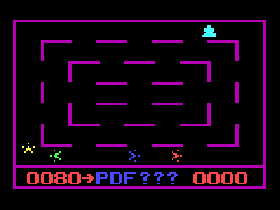 The Game: Four robotic tanks search methodically through a maze, trying to hunt you down. If you wind up in a straight line across or above/below the robot tanks, they will fire, even if a maze wall is in the way. Your job is to evade their fire, use the robots’ logic against them (i.e. try to get one tank to shoot another just because you’re in a straight line with them), or sneak up from behind and destroy them. Destroyed tanks leave a radioactive crater that you must avoid for the rest of that round; you advance to the next round by eliminating all of the tanks without being shot yourself. (Philips, 1983 – unreleased prototype)
The Game: Four robotic tanks search methodically through a maze, trying to hunt you down. If you wind up in a straight line across or above/below the robot tanks, they will fire, even if a maze wall is in the way. Your job is to evade their fire, use the robots’ logic against them (i.e. try to get one tank to shoot another just because you’re in a straight line with them), or sneak up from behind and destroy them. Destroyed tanks leave a radioactive crater that you must avoid for the rest of that round; you advance to the next round by eliminating all of the tanks without being shot yourself. (Philips, 1983 – unreleased prototype)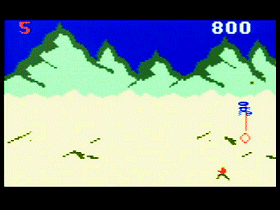 The Game: Robots descend from the mountains with one mission in mind: they’d like to fry you. In fact, they’re pretty adamant on that point. You’re armed with a weapon that can fling anti-robot grenades at them, but you have to account for a trajectory that can be affected by your own movement; mountainous outcroppings give you shelter, but not for long, since they also give the robots target practice. If you score a direct hit and blast a robot apart, you’re left with a narrow window of opportunity in which to land another grenade and permanently dismantle the remaining robot parts…if you can’t accomplish that, the robot will gather up its parts and reassemble itself to have another go at you. (Activision, 1983 – never released)
The Game: Robots descend from the mountains with one mission in mind: they’d like to fry you. In fact, they’re pretty adamant on that point. You’re armed with a weapon that can fling anti-robot grenades at them, but you have to account for a trajectory that can be affected by your own movement; mountainous outcroppings give you shelter, but not for long, since they also give the robots target practice. If you score a direct hit and blast a robot apart, you’re left with a narrow window of opportunity in which to land another grenade and permanently dismantle the remaining robot parts…if you can’t accomplish that, the robot will gather up its parts and reassemble itself to have another go at you. (Activision, 1983 – never released) The Game: The Green Goblin and his henchmen are terrorizing the city once more, and it’s up to Spider-Man to restore order. But the odds are against him: he can only attach his web to the surface of the building, naturally, but the
The Game: The Green Goblin and his henchmen are terrorizing the city once more, and it’s up to Spider-Man to restore order. But the odds are against him: he can only attach his web to the surface of the building, naturally, but the 
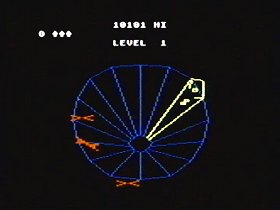 The Game: As a strangely crablike creature, you scuttle along the rim of an abstract, hollow geometric tube, zapping red bow-tie-ish critters and purple diamond-shaped things which carry them. There are also swirly green things which spin “spikes” like webs, and by the way, you should avoid spikes. (Atari, 1983)
The Game: As a strangely crablike creature, you scuttle along the rim of an abstract, hollow geometric tube, zapping red bow-tie-ish critters and purple diamond-shaped things which carry them. There are also swirly green things which spin “spikes” like webs, and by the way, you should avoid spikes. (Atari, 1983)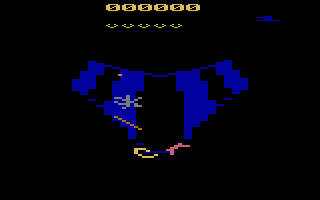 The Game: As a strangely crablike creature, you scuttle along the rim of an abstract, hollow geometric tube, zapping red bow-tie-ish critters and purple diamond-shaped things which carry them. There are also swirly green things (swirly thing alert!!) which spin “spikes” like webs, and by the way, you should avoid spikes. (Atari, 1983 – never released)
The Game: As a strangely crablike creature, you scuttle along the rim of an abstract, hollow geometric tube, zapping red bow-tie-ish critters and purple diamond-shaped things which carry them. There are also swirly green things (swirly thing alert!!) which spin “spikes” like webs, and by the way, you should avoid spikes. (Atari, 1983 – never released) The Game: As an intrepid, pith-helmeted explorer, you’re exploring King Tut’s catacombs, which are populated by a variety of killer bugs, birds, and other nasties. You’re capable of firing left and right, but not vertically – so any oncoming threats from above or below must be outrun or avoided. Warp portals will instantly whisk you away to other parts of the maze (though this doesn’t necessarily mean safer). Gathering all of the treasures and keys will allow you to open the vault at the end of each level…which leads to the next, and even more difficult level. It’s like The Mummy, only much more entertaining. (Parker Brothers, 1983 – unreleased prototype)
The Game: As an intrepid, pith-helmeted explorer, you’re exploring King Tut’s catacombs, which are populated by a variety of killer bugs, birds, and other nasties. You’re capable of firing left and right, but not vertically – so any oncoming threats from above or below must be outrun or avoided. Warp portals will instantly whisk you away to other parts of the maze (though this doesn’t necessarily mean safer). Gathering all of the treasures and keys will allow you to open the vault at the end of each level…which leads to the next, and even more difficult level. It’s like The Mummy, only much more entertaining. (Parker Brothers, 1983 – unreleased prototype) The Game: As the pilot of a lone space cruiser, you must try to clear the spaceways of a swarm of pesky and relatively harmless drone UFOs, but the job isn’t easy. You can ram the alien ships with your ship’s shields, destroying them (but forcing your shields offline for a few precious seconds during which anything could collide with your unprotected ship and destroy you), or shoot them (which also forces your shields down for a recharge). To that screenful of bite-sized chunks o’ death, add an unpredictable Killer UFO that likes to pop in and shoot at you, and suddenly being an interstellar traffic cop ain’t so easy. (Philips, 1983)
The Game: As the pilot of a lone space cruiser, you must try to clear the spaceways of a swarm of pesky and relatively harmless drone UFOs, but the job isn’t easy. You can ram the alien ships with your ship’s shields, destroying them (but forcing your shields offline for a few precious seconds during which anything could collide with your unprotected ship and destroy you), or shoot them (which also forces your shields down for a recharge). To that screenful of bite-sized chunks o’ death, add an unpredictable Killer UFO that likes to pop in and shoot at you, and suddenly being an interstellar traffic cop ain’t so easy. (Philips, 1983)